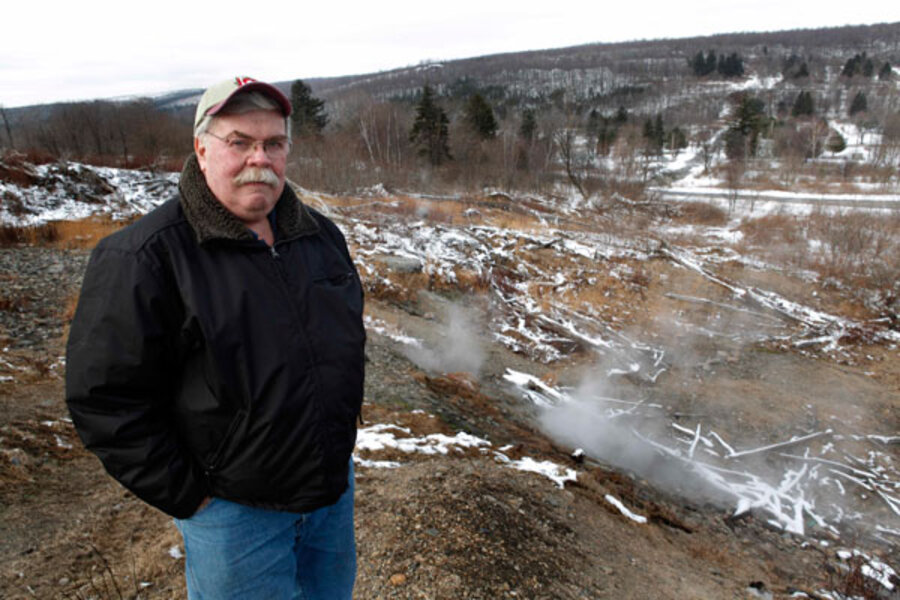Centralia, Pa., coal fire is one of hundreds that burn in the U.S.
Loading...
The fire burning deep below Centralia, Pa., is just one of numerous coal fires burning in at least 20 states today, with thousands more worldwide. They gobble up resources, spew dangerous emissions, and scar the land. Yet little is known about their impact on climate change or human health due to carbon dioxide and mercury emissions, say experts.
Approximately 200 underground coal fires burn in about 20 states, according to Glenn Stracher, a researcher at East Georgia College in Swainsboro, Ga., A separate tally shows 112 fire sites in 21 states, according to Office of Surface Mining data analyzed by Dr. Stracher and fellow researcher Ann Kim.
Causes of such coal fires range from spontaneous combustion to lightning to wildfires that ignite coal seams that then move underground to smolder and burn at temperatures that can reach 500 degrees F. or more.
Analysis of heat-fused rock "clinkers" shows that coal fires are an ancient phenomenon. "We've been dating clinkers, showing coal fires have occurred for at least couple of million years, so they're not new," says Mark Engle, a researcher at the US Geological Survey, "but undoubtedly human activity has exacerbated it."
Fires emit toxic emissions
In 2002, the US Environmental Protection Agency estimated that underground coal fires around the world emitted about 48 tons of mercury annually.
Worldwide, thousands of underground coal fires burn, with perhaps 1,300 in Indonesia alone, says Dr. Stracher, who is editing a four-volume scientific compilation of coal and peat fires around the world. He estimates that fires are burning in at least 20 nations, but notes that researchers have little understanding of their environmental damage and the scope of their impact on human health.
"The truth is, we don't really have a good regional or global estimate of emissions from these fires," Stracher says. "It's quite possible the emissions from these fires should be a significant part of the climate change models. We just don't know."
The coal fires also spew a lot of toxins into the atmosphere, causing water and soil pollution, he notes. Mercury is among the hazardous emissions – along with millions of tons of CO2. One estimate by French researchers in a 2007 study put carbon dioxide emissions from coal fires at .3 percent of global emissions.
But all such numbers are extrapolations and could be far higher – and so their exclusion from climate change models could be a major, even tragic, omission, says Dr. Engle.
Most underground coal fires can be found in big coal-consuming nations such as the US, China ,and India, where human activity, often mining, plays a major role in igniting them. In China, for instance, massive underground coal fires are thought to consume between 10 million and 200 million metric tons of coal annually – about .5 percent to 10 percent of that country's total production, according to research cited in a 2009 fact sheet published by the US Geological Survey.
Cost a deterrent to stopping fires
Some progress has been made on technology to put out the fires. One technique is to dig the fire out, Another is to build a trench around the fire. Other methods include using a type of grout and or even high-tech nitrogen foam to smother the fire. Almost always, however, the reason the fires get out of hand is that the cost to fight them is considered too high.
Efforts to extinguish underground coal fires in the US have cost $1 billion so far – about 90 percent of that in just two states, West Virginia and Pennsylvania, according to the Department of Interior's Office of Surface Mining Enforcement and Reclamation.
The fire in Centralia has been burning since 1962, when trash burning in a nearby abandoned strip mine used as an unregulated dump ignited the nearby Buck Mountain coal bed, according to Stracher, who has visited the site and conducted research there. The fire soon spread to mining tunnels beneath the town. Efforts by residents and federal authorities to put together a plan to fight the fire were unsuccessful.
Finally, between 1985 and 1991 the federal government appropriated $42 million to relocate residents and businesses because of the risk of pollution and subsidence. A few homes and residents remained. Until now.The state is moving to take possession or remaining homes and demolish them.
"I've been there many times," Stracher says. "It's just an eerie feeling to think that it's an area that was once a thriving community. You can almost sense the people that used to live there but are now gone.
He recalls seeing where houses once were, but are now just overgrown foundations with occasional rusty swing sets nearby.
"I can picture kids growing up here, yet the whole area, the dead vegetation, the smoke coming out of ground," he says. "It's pretty bizarre."





